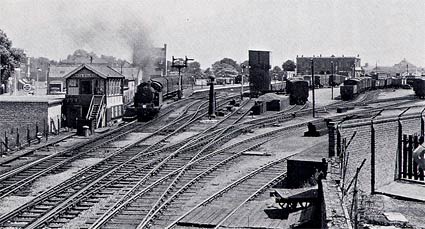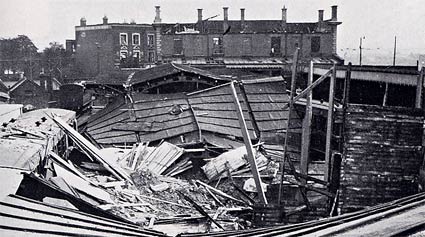A short history of the North Woolwich branch
The rise and fall of the docklands railway in London.
Report © urban75 editor, May 2006
History of the North Woolwich branch
The North Woolwich branch began life in 1846, when the Eastern Counties and Thames Junction railway was opened from Stratford via Stratford Bridge (later Stratford Market) station to Barking Road, Canning Town..

Bustling scene at North Woolwich station, 1961 [Photo: R C Riley]
Originally intended to exclusively carry coal traffic, the line was extended a year later to North Woolwich and opened up for passengers. A pier was built opposite the station to cater for cross-Thames traffic arriving via the Woolwich steam ferry.
The branch line was taken over by the Eastern Counties Railway the same year, with the construction of two huge docks necessitating later diversions.
The entrance to the first, Victoria Dock, cut across the line, so a new line was built in 1855 to take the route around the north side of the dock to Silvertown, where it re-connected with the original line.
The older, southern line - known as the Silvertown tramway - was kept to serve local factories, with a swing bridge being constructed to carry traffic over the dock entrance.
The second dock, the Royal Albert Dock, was constructed in 1880, with the railway being diverted through a tunnel cut between the two docks.
By this time, ownership of the line had changed hands, with the Grand Eastern Railway being formed when it amalgamated with the ECR and other railways in East Anglia in 1862.

By 1900, the area around the route was thoroughly urbanised, with docks and goods depots employing thousands of people and bringing profitable goods and passenger traffic to the line.
In 1923, Britain's railways were merged into four main groups, with the GER becoming swallowed up by the London and North Eastern Railway.
After the London Passenger Transport Board took over all bus, tram and railway systems in 1933, a new trolleybus service ran alongside much of the route to North Woolwich, severely impacting on train revenue.

North Woolwich station took a direct hit on September 7th, 1940, with trains standing in the station and platform canopies damaged and fire gutting the upper floor of the station building [Photo: BR]
Worst was to come with the outbreak of World War Two, with the line suffering multiple bombings during the Blitz.
After the war, passenger traffic further declined as workers were rehoused in 'prefabs' near Beckton and Wanstead Flats.
In the 1960s, local goods depots began to close as British Rail withdrew from single-wagonload traffic which were better suited for road transportation.
What finally did for the area was the introduction of container traffic depots downstream, which resulted in the almost overnight closure of the docks.
By the end of the 1970s, the line was in a parlous state, but investment from BR and the Greater London Council saw the service extended from Stratford over the North London line to Dalston Junction and Camden, with a Richmond to North Woolwich service being inaugurated in May 1985.
Now reduced to an unstaffed, single-track, branch line, the section from Silvertown to North Woolwich will be closed from September 2006, and replaced by a DLR extension whose route duplicates most of the current line.
|

